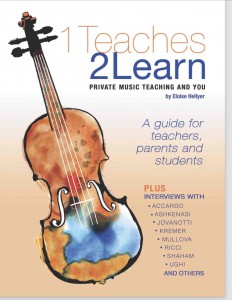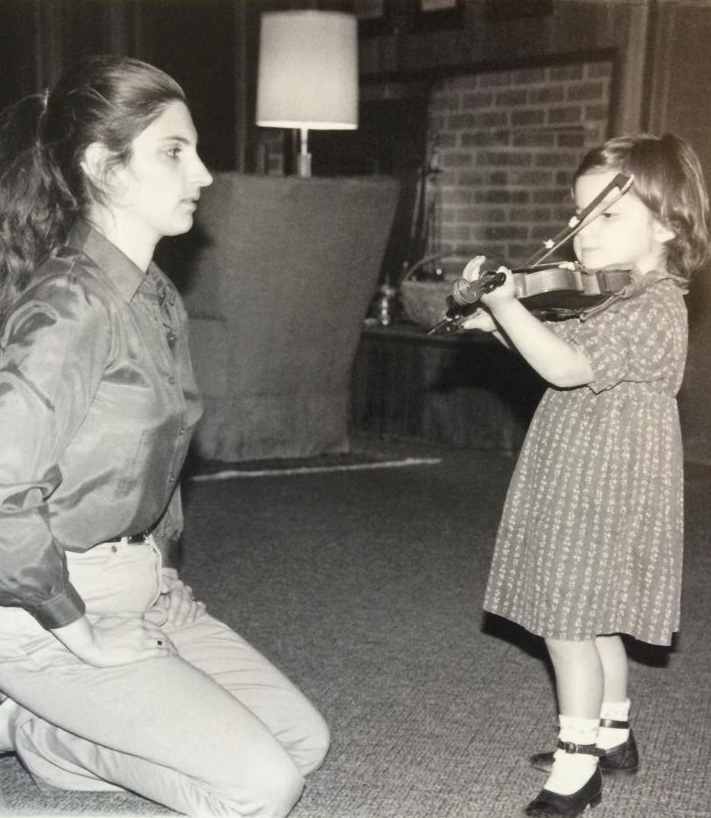Teaching Technique to Trying Tots - or Anyone Else For That Matter
How do you deal with students who you just can’t get to absorb an important technical aspect? Four-year-olds with a death-grip bow hold that no amount of tricks or pleading will relax? Wooden wrists that won’t bend no matter how many exercises you give them? Pancaking left hands that won’t even respond to toothpicks taped to the fingerboard (some parents get desperate)?
Yes, you say, these are problems we all face with our young beginners…
Certainly. But how about a late adolescent student who plays a Mozart concerto pretty darn well but doesn’t hold his violin up? You heard me right. A young adult with professional aspirations, advanced technique, and a droopy violin!
What does that have to do with our problems with our twinklers?
Quite a few years ago, I found myself watching a video of a masterclass on YouTube with a pedagogue, whom I didn’t know personally¹, teaching that sadly-postured young man. What deeply impressed me was how the teacher handled the situation: he gave that student excellent and very specific reasons (one of which I had never heard before and have since stolen from him – don’t tell!) to do as he suggested. I won’t go into specifics, although they were interesting, but he told the student how and why his sound would improve and his left-hand technique would get easier, gave specific instructions, asked the student to follow them, and while he did so, made him actively notice how much better his sound and left-hand technique were.
Now, do any of us seriously believe that this student could have gotten that far without all of his teachers and probably his parents telling him countless times: “FOR THE LOVE OF ALL THAT’S HOLY, HOLD YOUR VIOLIN UP (followed by 50 exclamation points)”? Of course they did. But here the difference was twofold:
- The student had technical problems he couldn’t solve and was finally ready to listen.
- The masterclass teacher then told him to hold up his violin and—this is the important part— proved to him how all these technical problems would be solved.
The scales fell from the student’s eyes, and the rest is history. I recently saw a YouTube video of him playing: his posture was perfect, and his playing was pretty near so.
But do we have to wait until our students are playing Paganini to get them to apply our excellent advice? How can we get our little students, who don’t seem to care about their technique, to acquire it?
Easy. Get them to care. Sometimes we get so caught up in the “what” and “how” of something, we forget to explain the “why.” You might think that four-year-olds can’t or won’t even want to understand. That may be true in some cases, but I have noticed something in many of my students that led to one of my now Very Important Principles:
Some (actually many) students, no matter how young, will not do something unless they have an excellent—according to them—reason for doing so.
The catch is “according to them.” You can give your own excellent reasons until you’re blue in the face, but if they don’t agree or truly understand them, you’re sunk. The problem is that children usually aren’t aware of this attitude. For them, their way of being is that they aren’t going to bother doing whatever it is you’re asking unless they see its importance. And they don’t have enough life experience to understand that there are other ways of being—or even that they have a way of being in the first place. Therefore, they couldn’t explain this to you even if they wanted to. And in any case, they aren’t in the habit of asking teachers why they should do something.
So, the best way is to show them how their sound improves when they have a proper bow hold, correct left-hand position, posture, etc. I will show the young ones two ways of doing something and ask which sound they prefer. I do the wrong way with a huge frown on my face and exaggerate whatever defect I am trying to correct, and then the right way with a sunny smile. Why? Because sometimes they actually like the awful sound, out-of-tune note, or bad position. It takes time for a lot of young children to learn to prefer music to noise (I’m looking at you, grandsons). From my frown or smile, they quickly understand which sound is desirable. They then have to want that beautiful sound in order to be amenable to learning the necessary technique. In any case, we are in this business to raise our students’ consciousness, aren’t we? Never assume that students will just get things on their own. Some of them need every little thing explained to them.
You see, this type of student won’t do something unless they want to. And they won’t want to unless they see, hear, and understand a clear and cogent reason for doing so that applies to them personally. I have found that simply praising them for doing things well is often not enough. And we teachers are often told that we should praise a lot and otherwise talk very little.
Obedience ≠ either intelligence or the lack of it
We teachers may also fall into the trap of thinking that students such as these have a problem, either physical or emotional, a learning disability, or just a lack of intelligence. “He just can’t get it”—for whatever reason we come up with—is a lot different from: “He won’t do it until the ‘why’ of what I’m asking hits him where he lives.” If you think about it, it’s a very intelligent reaction to demand a reason for things. If someone tells you, an adult, to do something, even a professional you trust, don’t they usually explain why? And if they don’t give an explanation, don’t you ask for one?
“I’ll only do it if you show me why” is an excellent way of thinking for students if we teachers know how to use this to our and really our students’ advantage. Once you have opened their eyes to something—and you may have to be persistent—then they will remember it. Of course, we would all love to have obedient students who always do what we ask the first time. But these children, who may seem easier to work with, tend to backslide a lot more in my experience. The more skeptical ones that you have to work harder with, reason with, and find ways to get to understand the “why” of things will be easier for us to teach in the long run. Consciously knowing why you do what you do will not only help you do it a lot better, but help you keep doing it a lot better, too. In any case, if you don’t understand why you do something, how can you correct yourself when you are having difficulty? And Teacher is not always available when a student runs into a roadblock.
One of our jobs is to help students develop the positive aspects of their qualities. But we have to see the positive side of their qualities first. While many teachers might interpret the above attitude negatively as stubbornness or being uncooperative, don’t we know why we do what we do? Why shouldn’t we share this with our students at every opportunity? “Do it this way because it’s better” is not going to work with a lot of independently-minded kids. Helping our students by telling them that while we can’t explain every single time why we do something, wanting to know and understand the reason behind technique is an excellent characteristic to develop. I tell my students that if they don’t understand (or don’t remember) the reason for doing something the way I’m insisting on, please stop me and ask. I will be more than happy to explain.
Of course, this doesn’t mean that even with excellent explanations, our students are going to always remember to do things the right way. Nevertheless, raising their awareness of not only sound, phrasing, and the why of technique but also of their own mental processes is going to go a long way in helping them become independent thinkers, practicers, musicians, and ultimately competent human beings.
It is said that knowledge sets you free. Some of us just need it sooner than others.
Post author: Eloise Hellyer
¹ Strangely enough, our paths crossed years later when I interviewed him for “1 Teaches 2 Learn” and then realized that he was the pedagogue in the video. He is David Russell, whose impressive CV includes teaching at CIM for 25 years. He is now a professor at UNC Charlotte and runs wonderful summer programs for violinists in the Adirondacks and Alcala-la-Real in Spain.
Share this:
Buy it on www.sharmusic.com - eBook format, avaliable worldwide, paperback in North America
COPYRIGHT
ABOUT
A music teacher’s thoughts and observations on the teaching and the study of a musical instrument, hoping to be of help to parents, students and teachers.
PHOTO
AWARDED TOP 25 VIOLIN BLOG
CATEGORIES
TAGS
ARCHIVES
-
Agosto 2022
Agosto 2023
Agosto 2024
April 2015
April 2016
April 2017
April 2019
April 2020
Aprile 2022
Aprile 2023
Aprile 2024
August 2014
August 2015
August 2016
August 2017
August 2018
August 2019
August 2021
December 2014
December 2015
December 2016
December 2017
December 2018
December 2019
December 2020
Dicembre 2022
Dicembre 2023
Dicembre 2024
Febbraio 2022
Febbraio 2023
Febbraio 2024
February 2015
February 2016
February 2018
February 2019
February 2020
February 2021
Gennaio 2022
Gennaio 2023
Gennaio 2024
Giugno 2022
Giugno 2022
Giugno 2023
Giugno 2024
January 2015
January 2016
January 2017
January 2018
January 2019
January 2020
July 2015
July 2017
July 2019
June 2016
June 2017
June 2018
June 2019
June 2020
June 2021
Luglio 2022
Luglio 2023
Luglio 2024
Maggio 2022
Maggio 2023
Maggio 2024
March 2015
March 2016
March 2017
March 2018
March 2019
March 2020
March 2021
Marzo 2022
Marzo 2023
Marzo 2024
May 2015
May 2016
May 2018
May 2019
May 2020
November 2014
November 2015
November 2016
November 2017
November 2018
November 2019
November 2021
Novembre 2022
Novembre 2023
Novembre 2024
October 2014
October 2015
October 2017
October 2018
October 2019
October 2020
October 2021
Ottobre 2022
Ottobre 2023
Ottobre 2024
September 2014
September 2015
September 2016
September 2018
September 2019
September 2020
September 2021
Settembre 2022
Settembre 2023
Settembre 2024
RECENT POSTS
Terry G and Me, or Terry Gilliam on Where (or What) Practicing the Piano Will Get You…
The Teaching We Don’t Do Is More Important Than We Think
Overwhelmingness or What Teaching and Motherhood* Have in Common
Cellphone Serenity
How to Build Your Reputation – the Kind You Want
Desperate Times, Desperate Measures. Or How to Deal With Your Strong-Willed Stubborn Student and Survive
“Why Does My Teacher Get So Frustrated?” Letter to a Perplexed Student
Mount Rush-no-more….And How to Get There
Realizzato con VelociBuilder - Another Project By: Marketing:Start! - Privacy Policy




